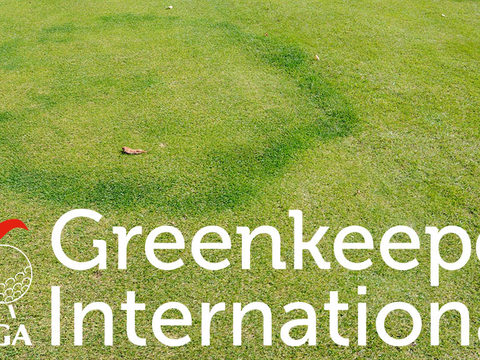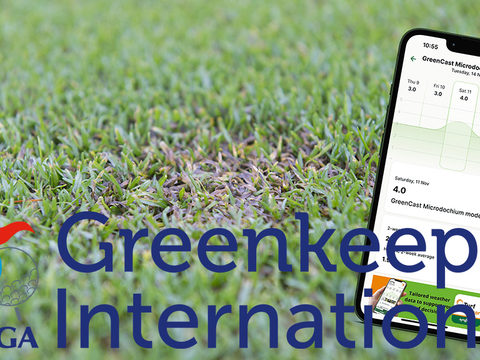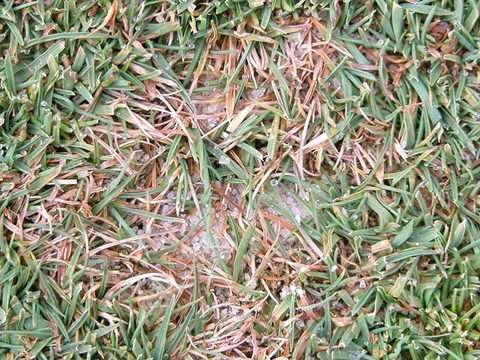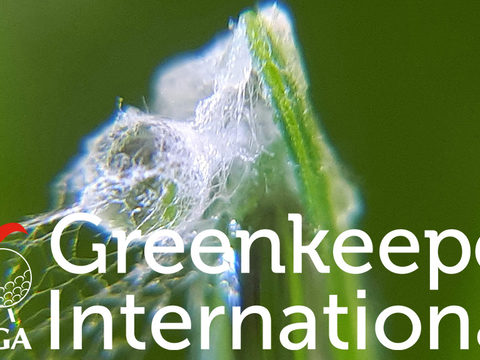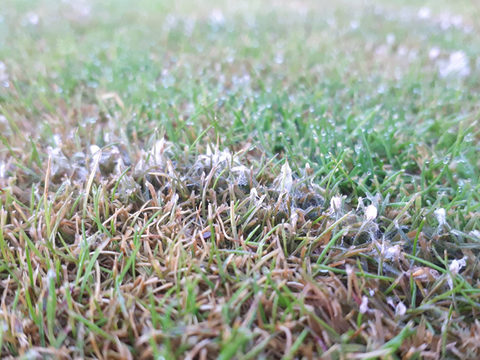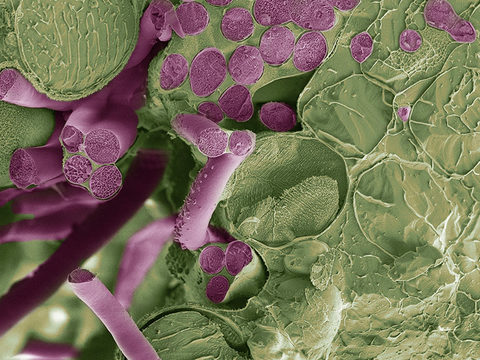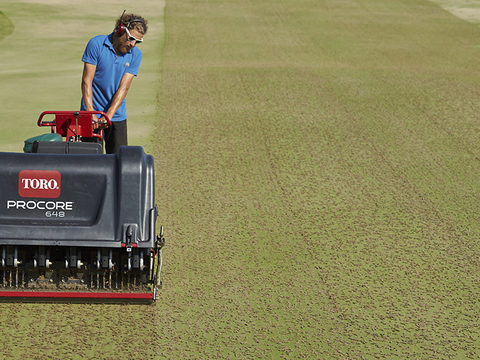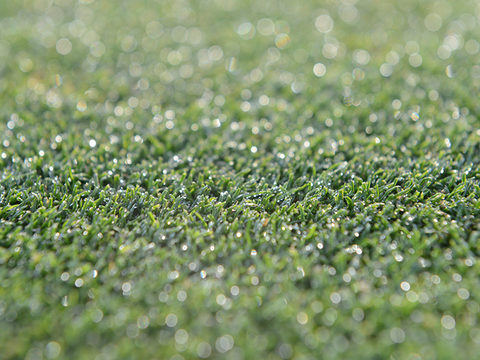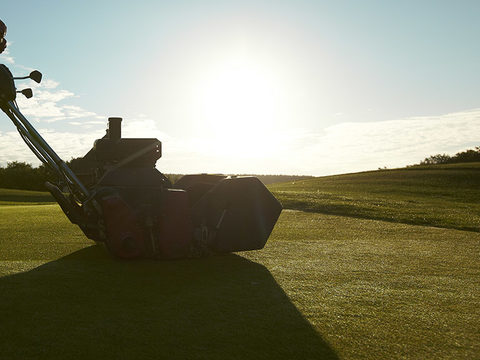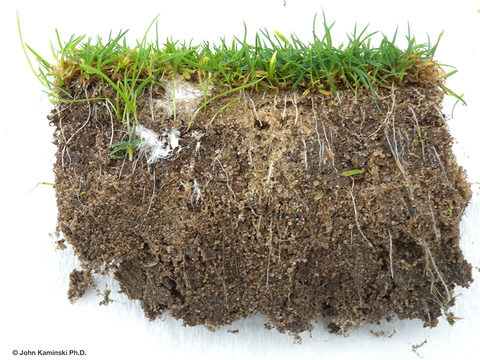Investing in Dollar spot
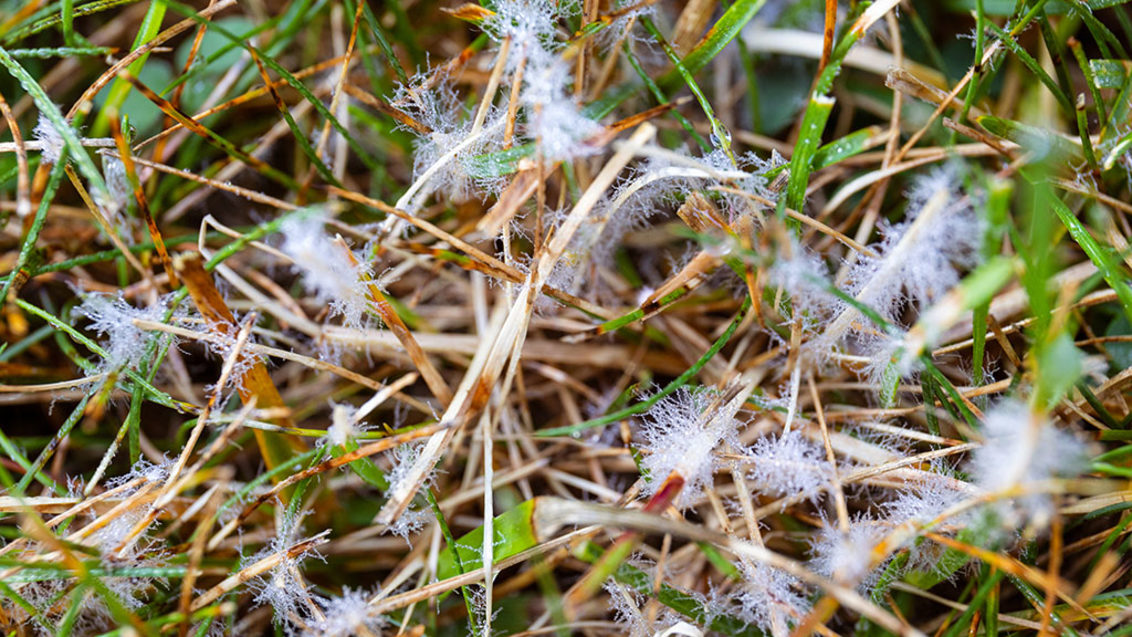
Dollar spot is under investigation in a new Syngenta UK turf research initiative, to better understand disease pressure modelling and the options for effective ITM strategies, reports Syngenta Technical Manager, Sean Loakes.
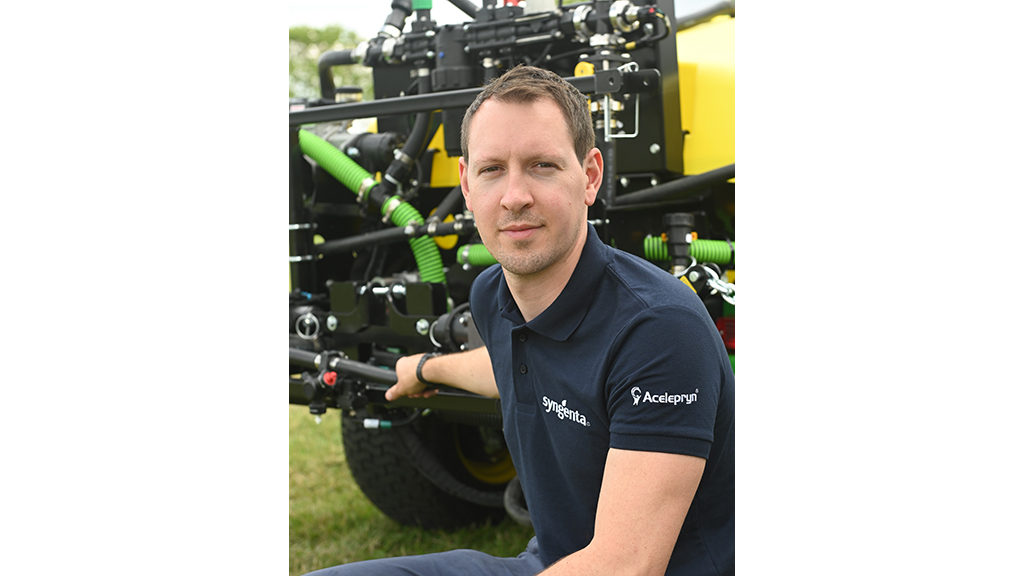
Dollar spot has been widely reported occurring earlier in the season than normal this year. On affected courses where outbreaks had typically been seen initially in July to September, the symptoms have been breaking out in May or June.
The trend of damaging Dollar spot attacks hitting earlier and with more severity has been increasing across Europe over recent years, with some valuable lessons for UK greenkeepers to get a step ahead and be more proactive in actions and timings.
One of the challenges is that Dollar spot pressure periods can occur over an extremely long window of the growing season. The damage is being exacerbated, particularly on tees, collars and fairways, where turf recovery is struggling in prolonged high stress and slow growth summer conditions with limited opportunity for turf recovery.
When the classic symptoms of small silvery patches - the size and appearance of a silver Dollar coin – start to coalesce, large areas of turf cover can be quickly lost.
Looking at historical records, conditions that can drive Dollar spot pressure can begin as early as April. Climatic pressure doesn’t normally hit the critical 20% treatment threshold on the Smith-Kerns model until mid- to late June in most seasons, but that can occur as early as mid-May – most notably in 2020, and again this spring.
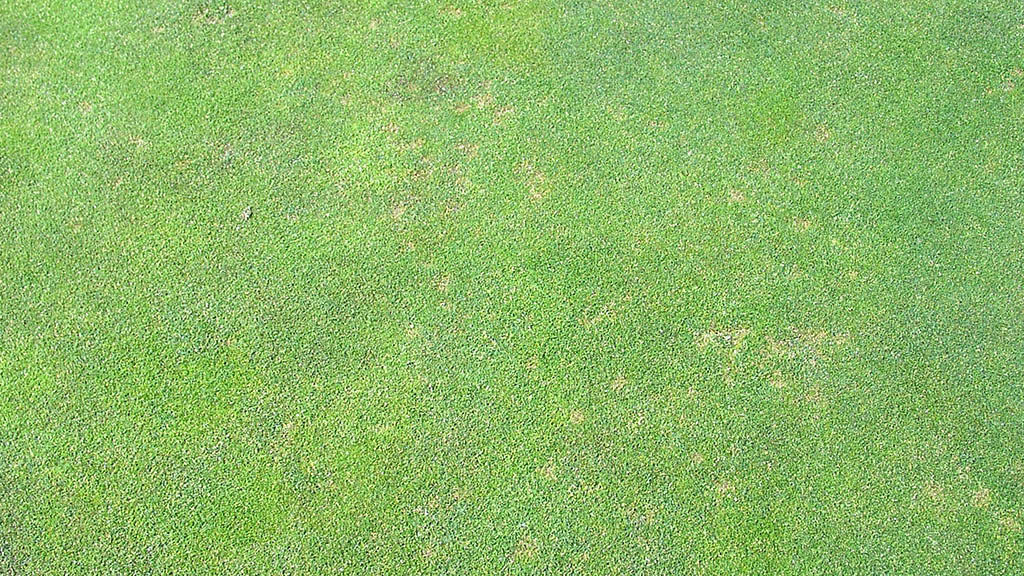
Over recent years, a degree of disease pressure has constantly remained right through the summer, with by far the most concentrated periods of prolonged pressure through July to September. However, it is notable that in some years repeated high pressure periods do occur through the autumn – exemplified in 2015 and again last year.
Furthermore, a useful analysis of the number of days per month with over 20% pressure prediction shows a significant peak in July, but the frequency of occurrences into September and October cannot be ignored particularly if the pathogen population got out of hand during the peak months.
The Smith-Kerns model does appear to give a good indication of Dollar spot pressure. Although it was designed for conditions in the US, where the disease is generally far more prevalent, it is now being fully evaluated in Syngenta research under UK conditions, as part of an evaluation for a new turf decision support app.
The model works by calculating rolling average temperatures over five-day period, combined with the humidity over the same period. The temperature assesses a range from 10⁰C that is the low point for Dollar spot development, to 35⁰C that is the high point above which it stops; the mid point - around 22.5⁰C - is the most favourable and highest pressure, decreasing above and below this point. When these temperature coincide with higher humidity the conditions are more conducive for disease pressure to be at its peak.
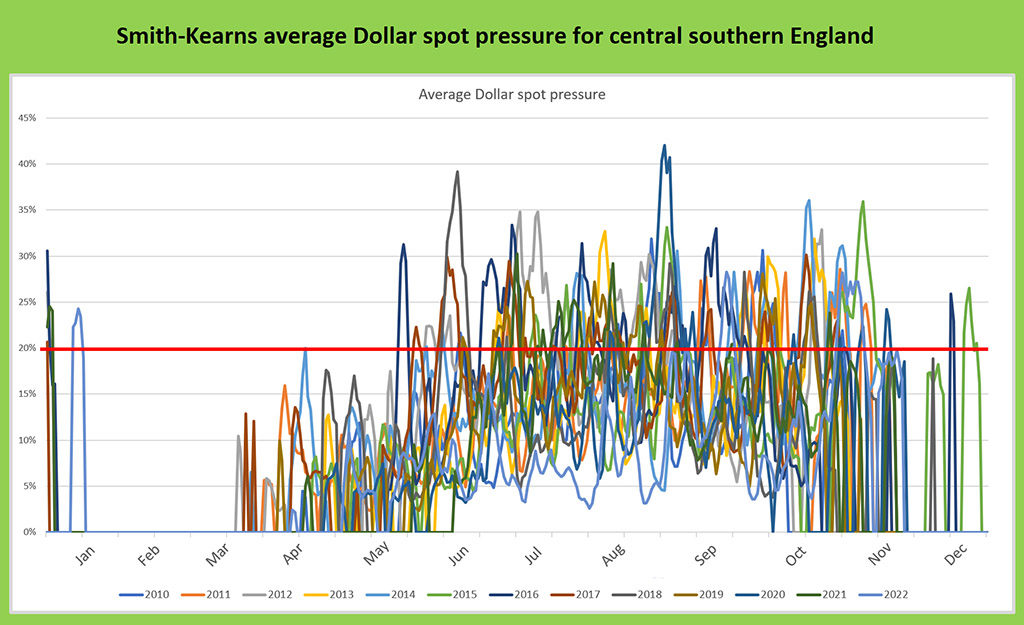
What the model indicates is that while disease can develop at higher or lower ends of the temperature spectrum, it would be slower and the pressure less. If the temperature and humidity is favourable, however, development and consequential turf damage can be extremely rapid. This really helps to effectively focus attention on actions and treatments at the optimum timings.
The Smith-Kerns model expresses the pressure as a percentage figure, where 20% is considered the threshold to trigger preventative measures.
The historical record of average Dollar spot pressure for central southern England highlights it has exceeded 40%, but sits between the 10 to 35% level through most summer conditions.
The challenge comes where changing climatic conditions are seeing periods of high pressure persisting for longer in more seasons. With occasional spikes of pressure around late December / early January, the concern is that these events will become a more regular occurrence with further changing climate.
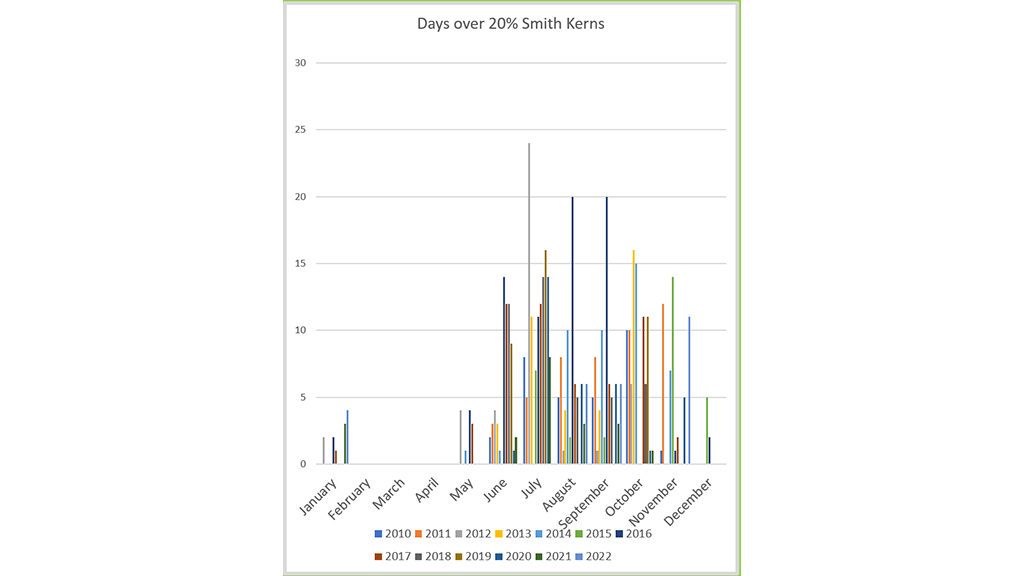
If you then overlay a 200 Growing Day Degree (GDD) calculation onto the Smith Kerns model, it is clear to see that short intervals for Primo Maxx II application also correlate with more rapid degradation of any fungicide treatment at the higher temperatures. The practical implication of that, is that when Dollar spot pressure is typically at its peak, the duration of fungicide protection may also be at its shortest, which needs to be considered with any protection programme.
It is no surprise that in the mid-west US, where Dollar spot pressure is regularly very high, superintendents often resort to a 10 to 15 day spray interval. Including more products that are specifically selected for Dollar spot and at higher rates than available in the UK.
Here, the best option would be Instrata Elite with the combined activity of fludioxonil and difenoconazole, while in Ireland they also have approval for Ascernity on golf turf that is highly effective against Dollar spot. Ascernity is currently being used on the trials for Dollar spot research in the UK.
Coupled to the fungicide strategy to prevent outbreaks, greenkeepers’ turf management actions can help to reduce the pressure and promote greater resilience to the disease pressure. Stressed turf is inherently more susceptible to infection, with any ITM measures to reduce stress helping to alleviate issues.
Extensive trials in the US have consistently shown the effects of Dollar spot are more severe when turf is under nutrient stress. The work indicates the key is to provide a consistent level of nutrition throughout the growing season, avoiding fertility flushes, through the use of controlled release fertiliser or regular repeated low dose applications.
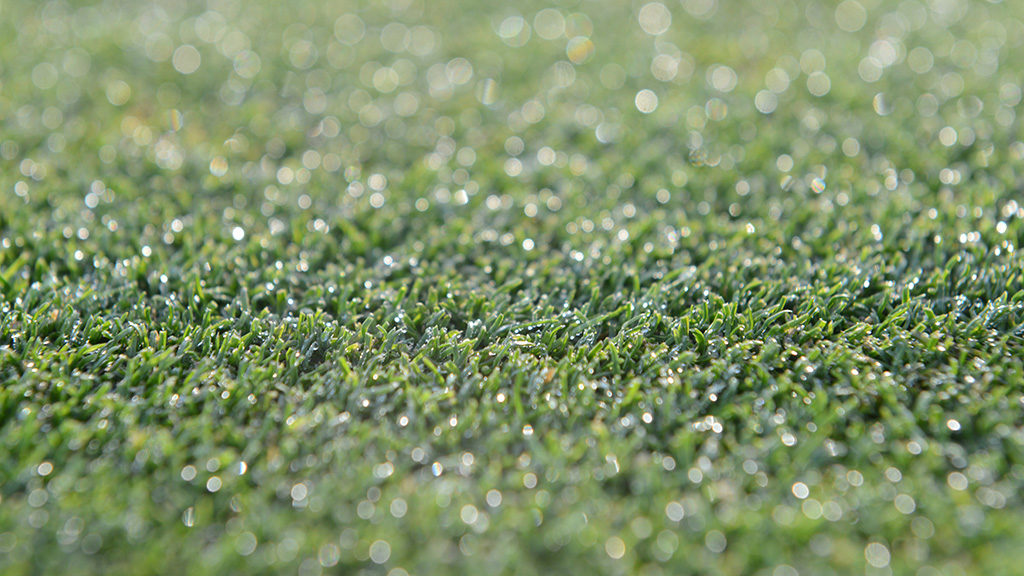
Soil moisture management has also proven highly effective in reducing stress on turf growth through the summer. Research has shown the emphasis is now firmly on starting Qualibra wetting agent programmes early enough in the season to preserve and utilise water resources in the soil when they are available, rather than leaving it too late when there is insufficient water to conserve and make a difference. That is especially important on fairways and tees relying predominantly on natural rainfall, where irrigation is limited or not available.
Since the development of Dollar spot is encouraged by higher humidity levels, improving air flow across the surface and limiting leaf wetness could help reduce localised pressure, along with good organic matter management practices.
We also know that the pathogen survives in the thatch, where a good greens’ aeration strategy could lower pressure and risk. That could also be a reason why increasing levels are being reported on approaches and fairways, where thatch build up is an issue, as well as a factor in this season’s early outbreaks as a legacy of the high incidence of infection last autumn.
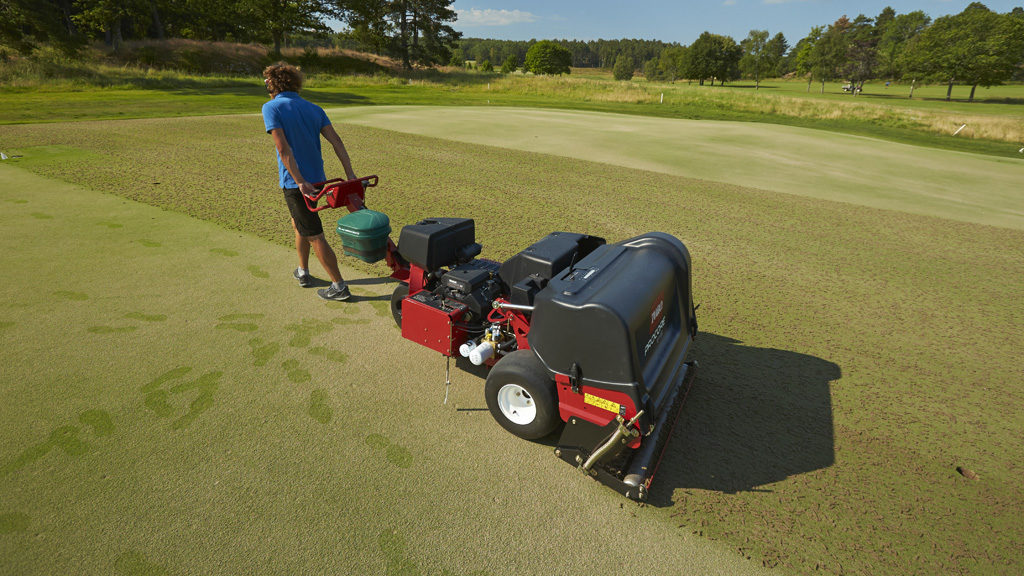
While Dollar spot will attack all turf grass species, it appears that, in general, annual meadow grass is most susceptible, along with creeping bent grass and then red fescue. Perennial ryegrass is less affected, with tall fescue the least impacted. However, there would also appear to be significant differences between the varieties of different cultivars within the species. Dollar spot resistance is an area of particular interest for plant breeders and, while it is generally a slow process to transition turf surfaces to new cultivars, is an area of great potential for ITM practices in the future.
Additionally, some of the new bioproducts developed to alleviate plant stress, such as Hicure, Ryder and new products in turf R&D evaluation, could have additional opportunity to enhance plant resilience.
Reliable modelling of Dollar spot and up to date disease risk information will ensure ITM practices can be prepared and in place ahead of upcoming challenges, along with optimised timing of fungicide applications to protect turf through the critical pressure points.
Dollar spot ITM actions
Andrew Howarth, Estate Manager at Gog Magog Golf Club in Cambridgeshire, reports finding Dollar spot is becoming more of an issue every year, with increased areas of the courses becoming affected.

“We first saw it on green surrounds, primarily on ‘non-play sides’ with least traffic, but over recent years this has progressed onto more ‘in-play’ areas, including tees and greens.
“It is more widespread across the courses and no longer confined to one particular soil type or grass species. It’s now extending beyond the most prevalent sand-based parts of the courses with high fescue content.”
Andrew attributes changes in climate as the overriding reason for the increasing incidence of the disease.
He regularly uses the Smith-Kerns model to monitor humidity and attempt to predict the rise in disease pressure. When these periods are identified, he carries out a number of ITM practices that include more turf rolling, increased dew removal to avoid leaf moisture, timed nutrient applications and other bio stimulants for plant health, along with fungicide applications in worst case scenarios.

“For over seeding we are now selecting cultivars that are more resistant to the disease, with the aim to produce a more tolerant sward composition,” he added.
Andrew Howarth’s ITM actions to counter Dollar spot:
- Increased turf rolling
- Dew removal
- Nutrient applications
- Biostimulants for turf health
- Fungicide applications
With the Smith-Kerns model he highlights that it is a case of getting into the habit of using this information. “I think the key to using it is learning at which point the trigger is for your site, and using the historical data of weather events to understand when the pressure will increase and what to expect when it does.
“We are at a point now where from mid-May to mid-September the model will be factored into all of our turf management decisions for greens surfaces.”
Andrew acknowledges there is still so much unknown about Dollar spot in the UK.
“We have had some success in suppressing it through different practices, without really fully understanding why?”
He believes it will be valuable for further research on both chemical and cultural Dollar spot controls, with data to back up any results so a clear strategy of management can be identified and implemented by turf managers - as with other turf pests and diseases.
“I am hoping that being involved with the Syngenta trials will give us a further understanding of the disease and climatic triggers through the Smith-Kerns model and ultimately what chemical control is possible.”

